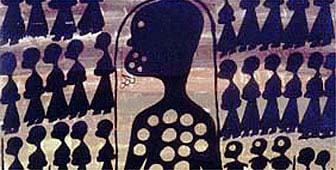Art of the loner in Lausanne

The solitude of the artist is paradoxically recalled by an exhibition entitled "Crowds" in Lausanne.
Paradoxically, because all the featured artists share an aversion to being in large groups of people, yet they have chosen to depict crowd scenes in their drawings and paintings.
These loners also have at least two other things in common: they are self-taught and they are marginal characters, either patients in psychiatric clinics, prisoners, or simply eccentric.
Art brut
The exhibition is in a museum housing the world’s finest permanent collection of “art brut”, which is known in English as “outsider art”. This concept dates back to around 1945 and is generally attributed to the French painter Jean Dubuffet – although awareness of it began with research by psychiatrists in the early 20th century.
Dubuffet said the term embraced works that were in their raw state, immune from cultural and artistic influences, adding “their creators take all subjects and materials from their own individuality and not from the base of classical art or stylish trends.”
He built up a collection of thousands of innovative works bearing no relation to developments in contemporary art, and presented it to the city of Lausanne. In 1976 it was given a permanent home in the Chateau de Beaulieu, which has since become a shrine for anyone interested in outsider art.
It’s been said that the purest of art brut creators would not consider themselves artists, nor would they even feel that they were producing art at all.
Secrecy and silence
However museum curator Lucienne Peiry has no doubt on this point: “Yes it is art,” she told swissinfo. “I’m convinced it’s art, but it is marginal art.”
Peiry, whose book “Art Brut – the origins of outsider art” is published in English by Flammarion of Paris, is fascinated by the works of these loner artists. “Each artist creates his or her own style, technique and subjects without talking to anyone about his or her creation,” she says. “Each creator works in anonymity as though filling the pages of a diary.
“Usually they live in solitude, secrecy and silence. We can even say that the people to whom the art is addressed are absent from the artist’s mind, so there is a complete absence from the artist’s mind of any yearning for social and artistic recognition.”
The artists represented in the exhibition include Carlo, a patient in an Italian psychiatric clinic. Peiry said: Carlo paints characters all the time, and seems to evoke the loss of human identity in the hospital where he’s spent so many years.”
Another painter, known as Helmut, lines up rows of hundreds of people attending sporting events or the circus, as though he was seeking to bring order to chaos.
“First-time visitors to our museum are often troubled and overwhelmed by what they see here,” said Peiry. “But everything they see is new and fresh.”
The exhibition “Crowds” ends on August 25.
by Richard Dawson

In compliance with the JTI standards
More: SWI swissinfo.ch certified by the Journalism Trust Initiative
You can find an overview of ongoing debates with our journalists here. Please join us!
If you want to start a conversation about a topic raised in this article or want to report factual errors, email us at english@swissinfo.ch.